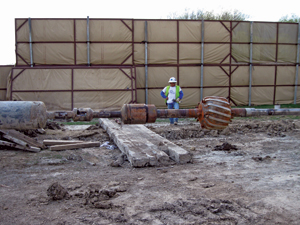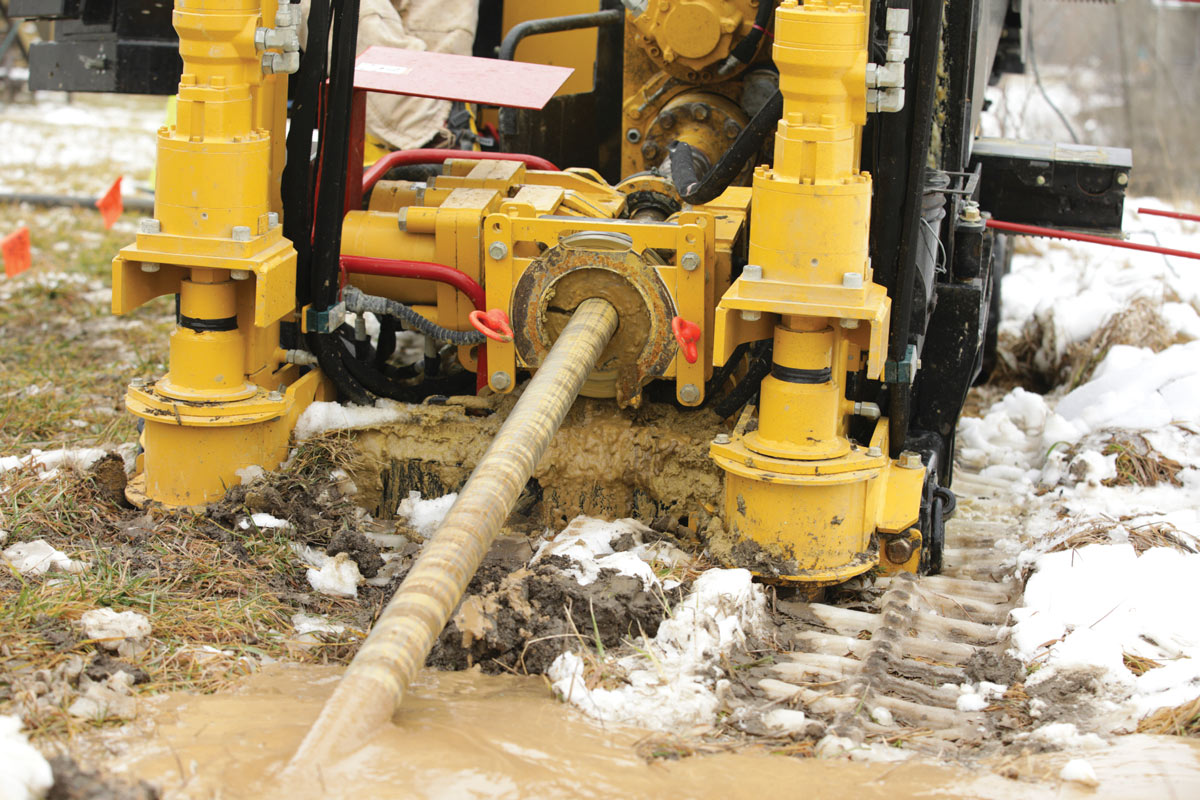HDD Used to Drill Under Texas Golf Course
November 22, 2011
 The project traversed two affluent Fort Worth, Texas, suburbs and ranks among the longest continuous bores in trenchless pipeline history. Affectionately known by officials with project owner Chesapeake Midstream Partners as FRAP (Fossil Ridge to Arc Park), the 5,967-ft section of underground pipeline has the distinction of being the longest horizontal directional drilling (HDD) bore attempted in Chesapeake Energy Corp.’s history related to the massive natural gas deposits of Barnett Shale.
The project traversed two affluent Fort Worth, Texas, suburbs and ranks among the longest continuous bores in trenchless pipeline history. Affectionately known by officials with project owner Chesapeake Midstream Partners as FRAP (Fossil Ridge to Arc Park), the 5,967-ft section of underground pipeline has the distinction of being the longest horizontal directional drilling (HDD) bore attempted in Chesapeake Energy Corp.’s history related to the massive natural gas deposits of Barnett Shale.Completed by Driver Pipeline, Irving, Texas, the bore was the second of a three-phase, 6.25-mile installation of a 24-in. pipeline to connect a main compressor station with well pads northeast of downtown Fort Worth. The FRAP pipeline serves as a gathering and transportation route for the immense deposits of natural gas contained within the Barnett Shale, connecting 12 different natural gas sites containing more than 55 wells in Fort Worth, North Richland Hills, Haltom City and Hurst, Texas. All future sites proposed in the north Loop 820 area will also use FRAP.
After months of preparation, Chesapeake identified a path that routed the pipeline through urban surroundings to its intended destination. Although FRAP was pulled across and under high-volume roads, as well as beneath public areas such as parks and golf courses, there was minimal interruption or inconvenience as most residents and businesses along the mile-plus route had no idea what was taking place some 135 ft below — a depth equivalent to that of an inverted nine-story building — beneath the surface.
“Location, location, location,” says Driver Pipeline HDD superintendent Harold Kay about the project challenges. “Most would assume the length of the bore and the rock would be primary concerns, but we were confident in the capabilities of the equipment. On this job, it was a combination of other factors, especially restricted access. The drill plan crossed under two golf courses, wetlands, along with deep creek beds with a lot of brush and trees. Restricted access to the middle of the bore route was an initial challenge.”
Rock Around the Clock
From the staging area that had been established in a city park, surrounded by a Frisbee course and ball fields, encompassed and camouflaged by a massive 16-ft tall wall barrier to minimize sound disruption for nearby residents, the Driver Pipeline crew secured its Vermeer D1000x900 Navigator horizontal directional drill and began the three-month, 24/7 drilling project. They selected an 8-3/4-in. rotor cone bit with mud motor, and 30-ft sections of 5-in. diameter drill pipe for the pilot bore.
With such tight tolerances (18 in. left to right) specified in the bore plan, there was little room for error. While the entry angle of 15 degrees, en route to an average drilling depth of 120 ft, might be considered somewhat steep, Kay explains the rationale.
“Having extensive experience in and around the Fort Worth area, we were already aware of a rock ledge that exists at about 32 to 34 ft below the surface,” Kay says. “If first contact with that ledge is made at less of an angle, say 6 to 7 degrees, the drill bit is likely to deflect and skip off the top. When this happens, the radius is too small for accommodating the large-inch diameter pipe. At the 15-degree entry angle, we felt confident that when we reached the rock, the angle was sufficient for the bit to grab and hold on the first try. It worked like a champ.”
The Driver Pipeline crew worked around the clock, safely navigating and boring — unseen, for the most part — beneath bustling roadways, quiet cul-de-sacs and tranquil fairways. Kay, along with Mike Webb, general superintendent in charge of directional drilling and surveying at Driver Pipeline, and Richard Norton, senior superintendent, had complete confidence in the crew and capabilities of the equipment.
Set design
Space restrictions and limited accessibility dictated that the initial staging area begin small with all the spoil being removed from the bore path and hauled away via vacuum trucks. Spoil not removed by vacuum, i.e., larger solids, were hauled off site daily by dump trucks. A driveway leading into an apartment complex was established as the site for the exit pit, with 24-hour guards posted to control traffic flow, restrict public access and assist residents in navigating around equipment barriers. From there, a winding rock road was constructed through a heavily wooded area to a phasing area that had been established near the golf course.
After 15 days of near-continuous drilling, the pilot bore was completed and the Driver team could begin the backreaming and pullback. This required three additional bores of 18, 26 and 36 in. to accommodate the 24-in., X65 FBE-coated steel pipe during pullback.
“Since we were cutting mostly through rock and shale, we felt it best to retool the reamer for the 18- and 36-in. bores,” Kay explains. “We cut just over 3,000 ft and then pushed the reamer back out and installed new cones and cutters. Our rotary torque was very low, a big advantage with using the Vermeer drill, and the rate of penetration stayed about the same from start to finish. The 26-in. ream, being the in-between shot, we were able to make in one solid cut without pushing out. It had been a long time since we made a crossing of that distance and we didn’t want to get 4,000 ft into it and have reamer problems. We knew the drill could handle it, there was just no reason to push the reamer.”
The Driver Pipeline crew was able to facilitate completion of the three reaming bores in 28 days, averaging about 360 ft every 12 hours, all while preparing the pipe for its final journey — and permanent home — situated some 120 ft securely underground. Pullback of more than a mile of steel pipe was all that remained to secure another successful installation for the cast and crew of Driver Pipeline. The pipeline was assembled in five separate sections.
The Driver Pipeline crew used a bentonite mud and soap mixture to lessen resistance and facilitate the pullback of the 377.8 tons of material, along with 152,159 lbs of 6-5/8-in. drill stem, totaling over 450 tons. The final pullback took 15 hours, followed by another 15-1/2 hours of pulling up mats.
 With the pipeline now firmly situated in its permanent underground home and the staging mats removed from the three holes along Diamond Oaks Country Club, Kay gave the “all clear” signal to the clubhouse and play on the three affected golf holes resumed — after only a one-day delay — as the Driver Pipeline crew started packing up.
With the pipeline now firmly situated in its permanent underground home and the staging mats removed from the three holes along Diamond Oaks Country Club, Kay gave the “all clear” signal to the clubhouse and play on the three affected golf holes resumed — after only a one-day delay — as the Driver Pipeline crew started packing up. Aside from a few minor procedural glitches, Mike Tucker, FRAP project manager for Chesapeake Midstream Partners, struggled to identify something about the project that didn’t go according to plan.
“In the 30-plus years I’ve been in the business, this is one of the most unique jobs I’ve ever been involved with,” Tucker said. “I’ve had projects where we drilled pipelines in the 4,000- to 5,000-ft range, but we weren’t in residential areas with apartments and golf courses like this. You go back 10 years and this length might have been a world record, especially when you consider the entire length was in solid rock. But technology and equipment has advanced so far in the last several years that we’re able to do this with greater confidence.”
Randy Happel is a features writer for Two Rivers Marketing, Pella, Iowa.





Comments are closed here.